Verbal & Non-Verbal Communication in Nursing: A Case Study Analysis
VerifiedAdded on 2023/04/24
|7
|1609
|435
Essay
AI Summary
This essay explores the critical role of nursing communication in patient care, emphasizing the importance of verbal and non-verbal techniques to establish therapeutic relationships. It highlights the need for nurses to introduce themselves effectively, practice active listening, and use open-ended questions to gather patient history. The essay also discusses the significance of observing patient body language and speech to identify underlying psychological issues, particularly in cases of psychosocial isolation and depression. It advocates for a humanistic counseling approach, focusing on neurovascular and psychological assessments, and emphasizes the importance of considering a patient's social, religious, and cultural views. The essay concludes by recommending an eclectic counseling approach to restore a patient's connection with reality and promote a healthy lifestyle, underscoring the role of effective communication in building trust and facilitating shared decision-making for improved patient outcomes. Desklib offers a wealth of similar resources for students.

RUNNING HEAD: NURSING COMMUNICATION
NURSING COMMUNICATION
Name of Student
Name of University
Author note
NURSING COMMUNICATION
Name of Student
Name of University
Author note
Paraphrase This Document
Need a fresh take? Get an instant paraphrase of this document with our AI Paraphraser
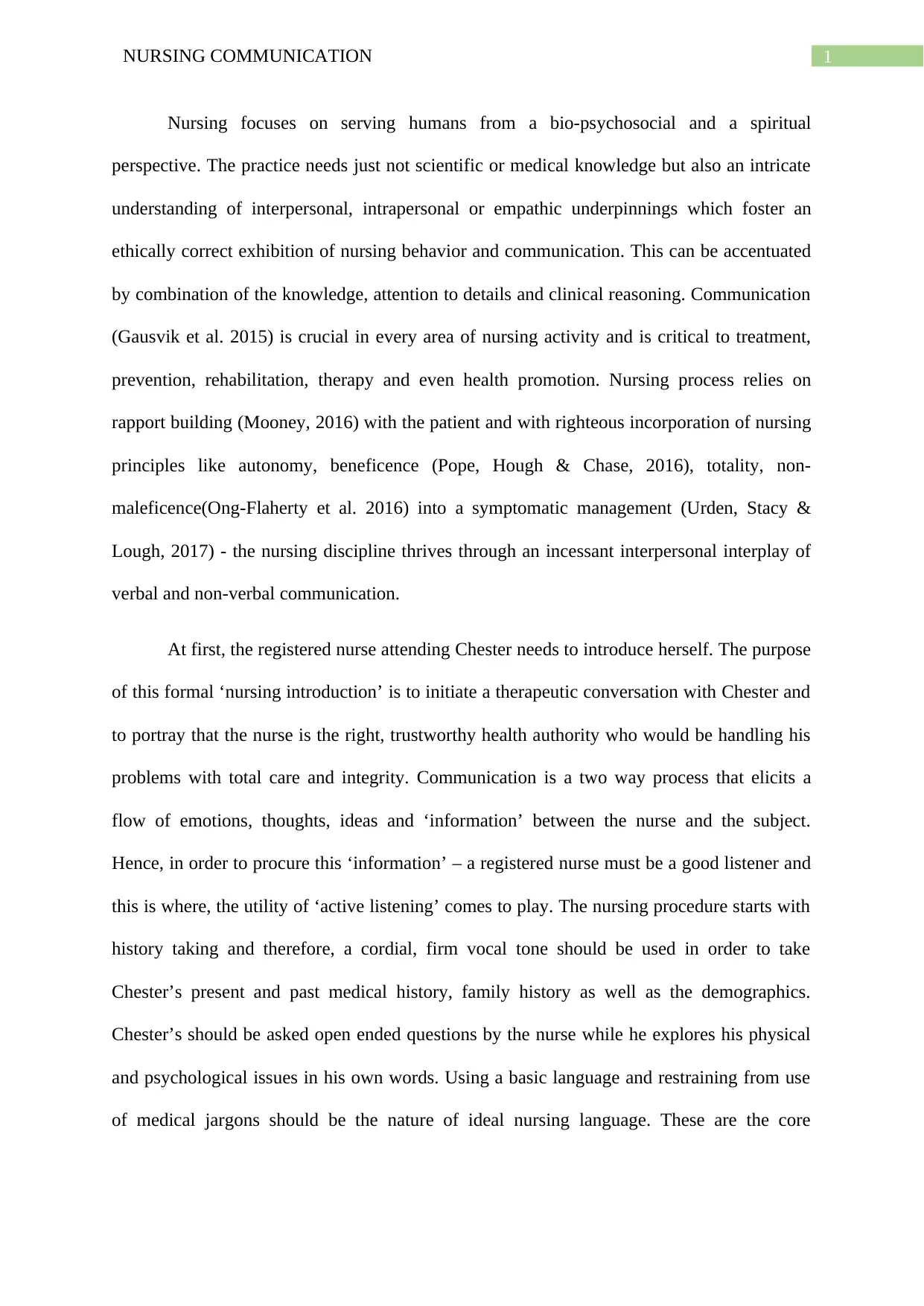
1NURSING COMMUNICATION
Nursing focuses on serving humans from a bio-psychosocial and a spiritual
perspective. The practice needs just not scientific or medical knowledge but also an intricate
understanding of interpersonal, intrapersonal or empathic underpinnings which foster an
ethically correct exhibition of nursing behavior and communication. This can be accentuated
by combination of the knowledge, attention to details and clinical reasoning. Communication
(Gausvik et al. 2015) is crucial in every area of nursing activity and is critical to treatment,
prevention, rehabilitation, therapy and even health promotion. Nursing process relies on
rapport building (Mooney, 2016) with the patient and with righteous incorporation of nursing
principles like autonomy, beneficence (Pope, Hough & Chase, 2016), totality, non-
maleficence(Ong-Flaherty et al. 2016) into a symptomatic management (Urden, Stacy &
Lough, 2017) - the nursing discipline thrives through an incessant interpersonal interplay of
verbal and non-verbal communication.
At first, the registered nurse attending Chester needs to introduce herself. The purpose
of this formal ‘nursing introduction’ is to initiate a therapeutic conversation with Chester and
to portray that the nurse is the right, trustworthy health authority who would be handling his
problems with total care and integrity. Communication is a two way process that elicits a
flow of emotions, thoughts, ideas and ‘information’ between the nurse and the subject.
Hence, in order to procure this ‘information’ – a registered nurse must be a good listener and
this is where, the utility of ‘active listening’ comes to play. The nursing procedure starts with
history taking and therefore, a cordial, firm vocal tone should be used in order to take
Chester’s present and past medical history, family history as well as the demographics.
Chester’s should be asked open ended questions by the nurse while he explores his physical
and psychological issues in his own words. Using a basic language and restraining from use
of medical jargons should be the nature of ideal nursing language. These are the core
Nursing focuses on serving humans from a bio-psychosocial and a spiritual
perspective. The practice needs just not scientific or medical knowledge but also an intricate
understanding of interpersonal, intrapersonal or empathic underpinnings which foster an
ethically correct exhibition of nursing behavior and communication. This can be accentuated
by combination of the knowledge, attention to details and clinical reasoning. Communication
(Gausvik et al. 2015) is crucial in every area of nursing activity and is critical to treatment,
prevention, rehabilitation, therapy and even health promotion. Nursing process relies on
rapport building (Mooney, 2016) with the patient and with righteous incorporation of nursing
principles like autonomy, beneficence (Pope, Hough & Chase, 2016), totality, non-
maleficence(Ong-Flaherty et al. 2016) into a symptomatic management (Urden, Stacy &
Lough, 2017) - the nursing discipline thrives through an incessant interpersonal interplay of
verbal and non-verbal communication.
At first, the registered nurse attending Chester needs to introduce herself. The purpose
of this formal ‘nursing introduction’ is to initiate a therapeutic conversation with Chester and
to portray that the nurse is the right, trustworthy health authority who would be handling his
problems with total care and integrity. Communication is a two way process that elicits a
flow of emotions, thoughts, ideas and ‘information’ between the nurse and the subject.
Hence, in order to procure this ‘information’ – a registered nurse must be a good listener and
this is where, the utility of ‘active listening’ comes to play. The nursing procedure starts with
history taking and therefore, a cordial, firm vocal tone should be used in order to take
Chester’s present and past medical history, family history as well as the demographics.
Chester’s should be asked open ended questions by the nurse while he explores his physical
and psychological issues in his own words. Using a basic language and restraining from use
of medical jargons should be the nature of ideal nursing language. These are the core
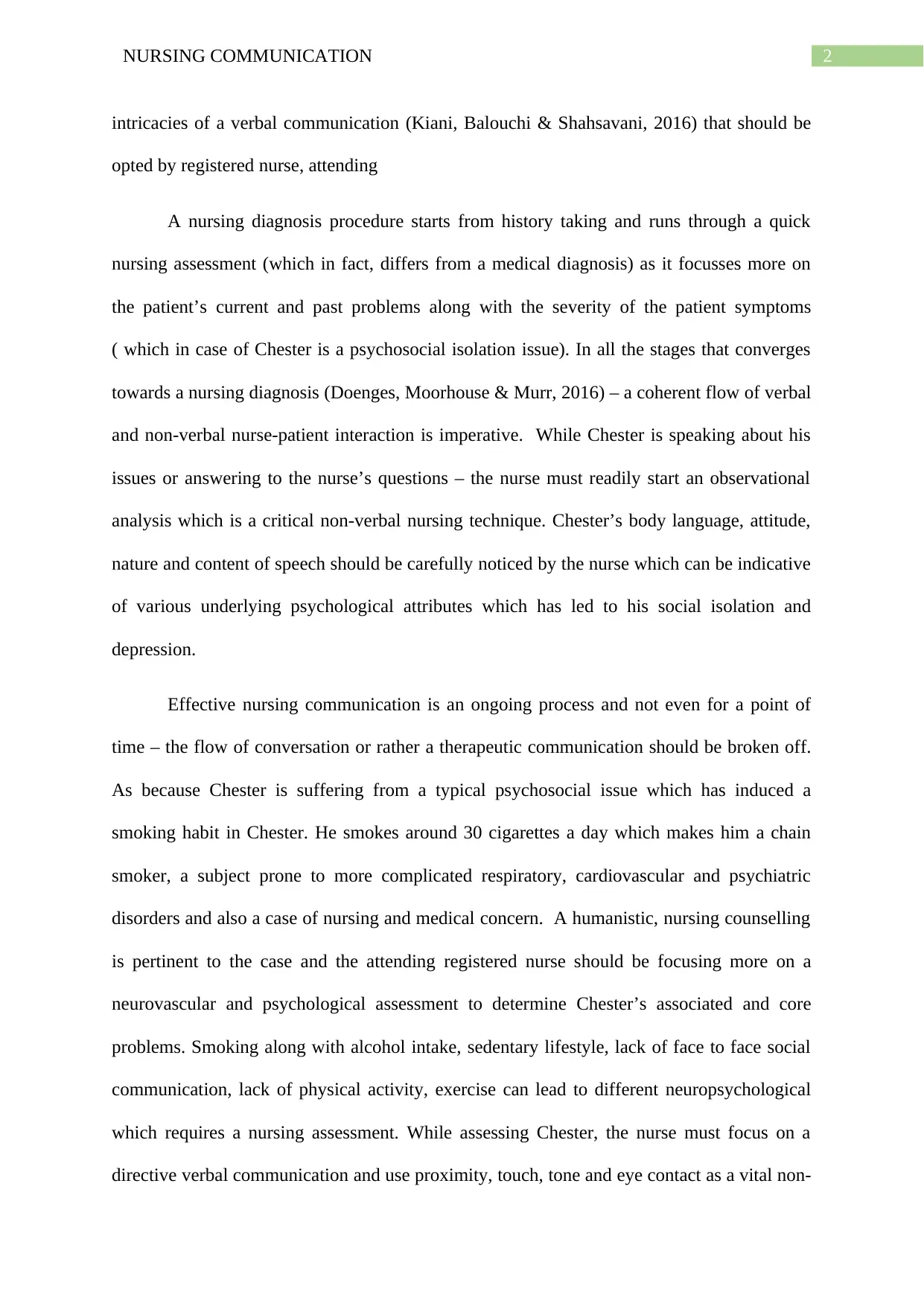
2NURSING COMMUNICATION
intricacies of a verbal communication (Kiani, Balouchi & Shahsavani, 2016) that should be
opted by registered nurse, attending
A nursing diagnosis procedure starts from history taking and runs through a quick
nursing assessment (which in fact, differs from a medical diagnosis) as it focusses more on
the patient’s current and past problems along with the severity of the patient symptoms
( which in case of Chester is a psychosocial isolation issue). In all the stages that converges
towards a nursing diagnosis (Doenges, Moorhouse & Murr, 2016) – a coherent flow of verbal
and non-verbal nurse-patient interaction is imperative. While Chester is speaking about his
issues or answering to the nurse’s questions – the nurse must readily start an observational
analysis which is a critical non-verbal nursing technique. Chester’s body language, attitude,
nature and content of speech should be carefully noticed by the nurse which can be indicative
of various underlying psychological attributes which has led to his social isolation and
depression.
Effective nursing communication is an ongoing process and not even for a point of
time – the flow of conversation or rather a therapeutic communication should be broken off.
As because Chester is suffering from a typical psychosocial issue which has induced a
smoking habit in Chester. He smokes around 30 cigarettes a day which makes him a chain
smoker, a subject prone to more complicated respiratory, cardiovascular and psychiatric
disorders and also a case of nursing and medical concern. A humanistic, nursing counselling
is pertinent to the case and the attending registered nurse should be focusing more on a
neurovascular and psychological assessment to determine Chester’s associated and core
problems. Smoking along with alcohol intake, sedentary lifestyle, lack of face to face social
communication, lack of physical activity, exercise can lead to different neuropsychological
which requires a nursing assessment. While assessing Chester, the nurse must focus on a
directive verbal communication and use proximity, touch, tone and eye contact as a vital non-
intricacies of a verbal communication (Kiani, Balouchi & Shahsavani, 2016) that should be
opted by registered nurse, attending
A nursing diagnosis procedure starts from history taking and runs through a quick
nursing assessment (which in fact, differs from a medical diagnosis) as it focusses more on
the patient’s current and past problems along with the severity of the patient symptoms
( which in case of Chester is a psychosocial isolation issue). In all the stages that converges
towards a nursing diagnosis (Doenges, Moorhouse & Murr, 2016) – a coherent flow of verbal
and non-verbal nurse-patient interaction is imperative. While Chester is speaking about his
issues or answering to the nurse’s questions – the nurse must readily start an observational
analysis which is a critical non-verbal nursing technique. Chester’s body language, attitude,
nature and content of speech should be carefully noticed by the nurse which can be indicative
of various underlying psychological attributes which has led to his social isolation and
depression.
Effective nursing communication is an ongoing process and not even for a point of
time – the flow of conversation or rather a therapeutic communication should be broken off.
As because Chester is suffering from a typical psychosocial issue which has induced a
smoking habit in Chester. He smokes around 30 cigarettes a day which makes him a chain
smoker, a subject prone to more complicated respiratory, cardiovascular and psychiatric
disorders and also a case of nursing and medical concern. A humanistic, nursing counselling
is pertinent to the case and the attending registered nurse should be focusing more on a
neurovascular and psychological assessment to determine Chester’s associated and core
problems. Smoking along with alcohol intake, sedentary lifestyle, lack of face to face social
communication, lack of physical activity, exercise can lead to different neuropsychological
which requires a nursing assessment. While assessing Chester, the nurse must focus on a
directive verbal communication and use proximity, touch, tone and eye contact as a vital non-
⊘ This is a preview!⊘
Do you want full access?
Subscribe today to unlock all pages.

Trusted by 1+ million students worldwide
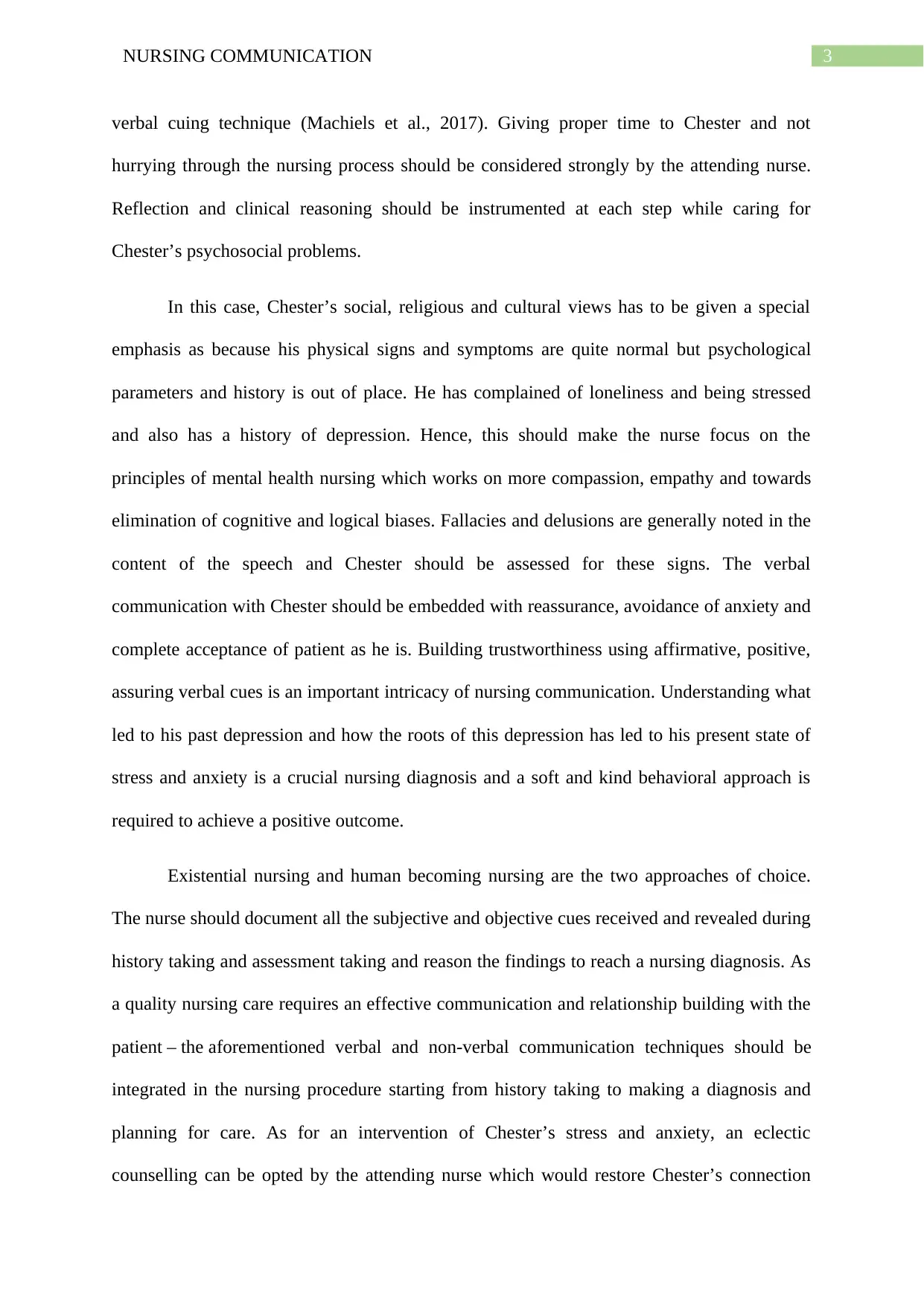
3NURSING COMMUNICATION
verbal cuing technique (Machiels et al., 2017). Giving proper time to Chester and not
hurrying through the nursing process should be considered strongly by the attending nurse.
Reflection and clinical reasoning should be instrumented at each step while caring for
Chester’s psychosocial problems.
In this case, Chester’s social, religious and cultural views has to be given a special
emphasis as because his physical signs and symptoms are quite normal but psychological
parameters and history is out of place. He has complained of loneliness and being stressed
and also has a history of depression. Hence, this should make the nurse focus on the
principles of mental health nursing which works on more compassion, empathy and towards
elimination of cognitive and logical biases. Fallacies and delusions are generally noted in the
content of the speech and Chester should be assessed for these signs. The verbal
communication with Chester should be embedded with reassurance, avoidance of anxiety and
complete acceptance of patient as he is. Building trustworthiness using affirmative, positive,
assuring verbal cues is an important intricacy of nursing communication. Understanding what
led to his past depression and how the roots of this depression has led to his present state of
stress and anxiety is a crucial nursing diagnosis and a soft and kind behavioral approach is
required to achieve a positive outcome.
Existential nursing and human becoming nursing are the two approaches of choice.
The nurse should document all the subjective and objective cues received and revealed during
history taking and assessment taking and reason the findings to reach a nursing diagnosis. As
a quality nursing care requires an effective communication and relationship building with the
patient – the aforementioned verbal and non-verbal communication techniques should be
integrated in the nursing procedure starting from history taking to making a diagnosis and
planning for care. As for an intervention of Chester’s stress and anxiety, an eclectic
counselling can be opted by the attending nurse which would restore Chester’s connection
verbal cuing technique (Machiels et al., 2017). Giving proper time to Chester and not
hurrying through the nursing process should be considered strongly by the attending nurse.
Reflection and clinical reasoning should be instrumented at each step while caring for
Chester’s psychosocial problems.
In this case, Chester’s social, religious and cultural views has to be given a special
emphasis as because his physical signs and symptoms are quite normal but psychological
parameters and history is out of place. He has complained of loneliness and being stressed
and also has a history of depression. Hence, this should make the nurse focus on the
principles of mental health nursing which works on more compassion, empathy and towards
elimination of cognitive and logical biases. Fallacies and delusions are generally noted in the
content of the speech and Chester should be assessed for these signs. The verbal
communication with Chester should be embedded with reassurance, avoidance of anxiety and
complete acceptance of patient as he is. Building trustworthiness using affirmative, positive,
assuring verbal cues is an important intricacy of nursing communication. Understanding what
led to his past depression and how the roots of this depression has led to his present state of
stress and anxiety is a crucial nursing diagnosis and a soft and kind behavioral approach is
required to achieve a positive outcome.
Existential nursing and human becoming nursing are the two approaches of choice.
The nurse should document all the subjective and objective cues received and revealed during
history taking and assessment taking and reason the findings to reach a nursing diagnosis. As
a quality nursing care requires an effective communication and relationship building with the
patient – the aforementioned verbal and non-verbal communication techniques should be
integrated in the nursing procedure starting from history taking to making a diagnosis and
planning for care. As for an intervention of Chester’s stress and anxiety, an eclectic
counselling can be opted by the attending nurse which would restore Chester’s connection
Paraphrase This Document
Need a fresh take? Get an instant paraphrase of this document with our AI Paraphraser

4NURSING COMMUNICATION
with reality and make him realize his present circumstances. As he is already cognizant of the
exercise and positive lifestyle needs which would better his present condition – all that the
nurse requires to do is maintain the ‘self-motivation’ in Chester and keep him enthusiastic
towards the experience of life. A nutritional change can be considered as Chester is living on
a monotonous diet for a long time and this can add to aggravation of personal and social
drives. The nurse should use ‘therapeutic communication’ and shared decision making to
help Chester a healthy life style and to eliminate the ‘triggers’ of depression. Taking Chester
into confidence is a cardinal nursing communication and treatment strategy.
with reality and make him realize his present circumstances. As he is already cognizant of the
exercise and positive lifestyle needs which would better his present condition – all that the
nurse requires to do is maintain the ‘self-motivation’ in Chester and keep him enthusiastic
towards the experience of life. A nutritional change can be considered as Chester is living on
a monotonous diet for a long time and this can add to aggravation of personal and social
drives. The nurse should use ‘therapeutic communication’ and shared decision making to
help Chester a healthy life style and to eliminate the ‘triggers’ of depression. Taking Chester
into confidence is a cardinal nursing communication and treatment strategy.
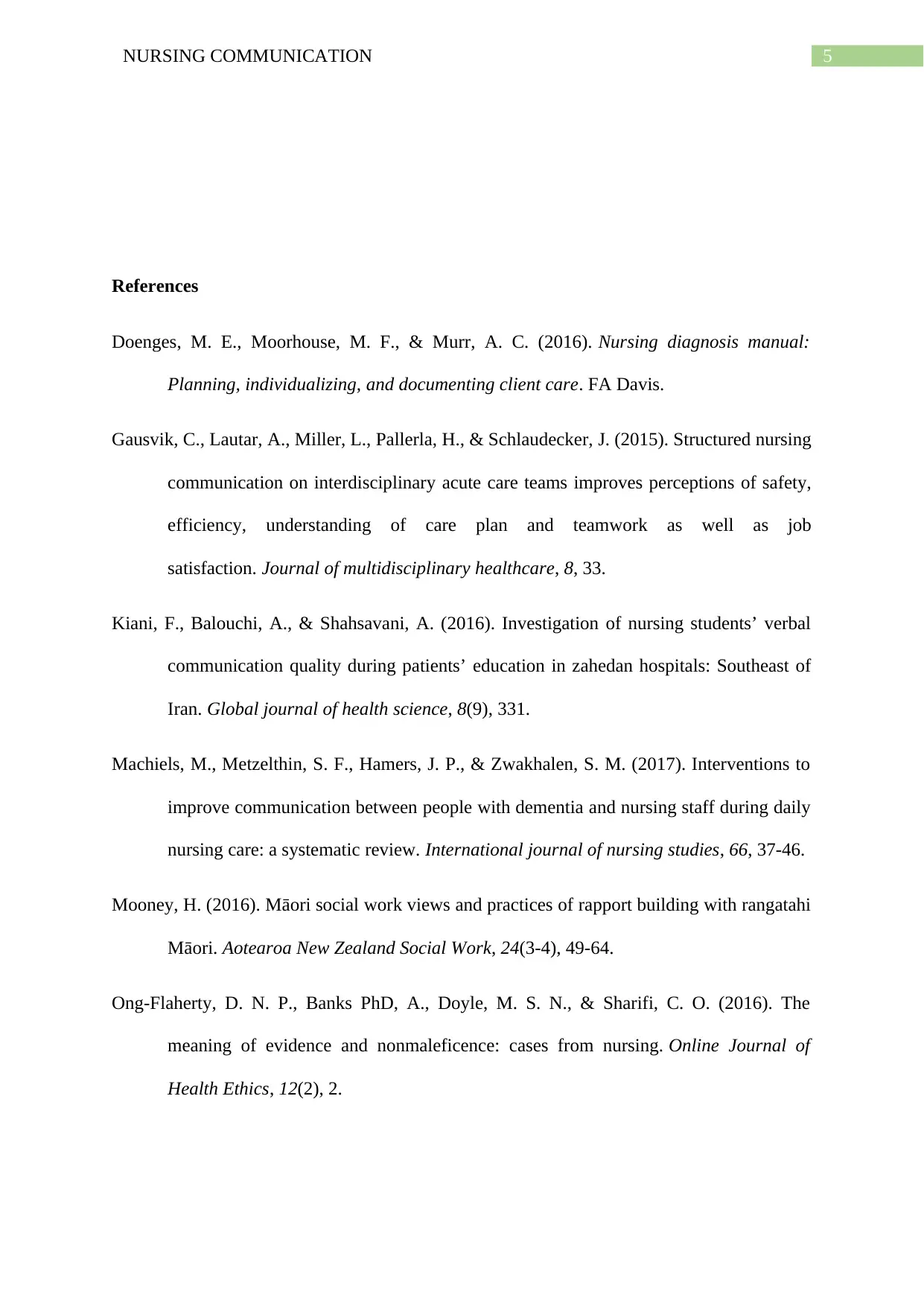
5NURSING COMMUNICATION
References
Doenges, M. E., Moorhouse, M. F., & Murr, A. C. (2016). Nursing diagnosis manual:
Planning, individualizing, and documenting client care. FA Davis.
Gausvik, C., Lautar, A., Miller, L., Pallerla, H., & Schlaudecker, J. (2015). Structured nursing
communication on interdisciplinary acute care teams improves perceptions of safety,
efficiency, understanding of care plan and teamwork as well as job
satisfaction. Journal of multidisciplinary healthcare, 8, 33.
Kiani, F., Balouchi, A., & Shahsavani, A. (2016). Investigation of nursing students’ verbal
communication quality during patients’ education in zahedan hospitals: Southeast of
Iran. Global journal of health science, 8(9), 331.
Machiels, M., Metzelthin, S. F., Hamers, J. P., & Zwakhalen, S. M. (2017). Interventions to
improve communication between people with dementia and nursing staff during daily
nursing care: a systematic review. International journal of nursing studies, 66, 37-46.
Mooney, H. (2016). Māori social work views and practices of rapport building with rangatahi
Māori. Aotearoa New Zealand Social Work, 24(3-4), 49-64.
Ong-Flaherty, D. N. P., Banks PhD, A., Doyle, M. S. N., & Sharifi, C. O. (2016). The
meaning of evidence and nonmaleficence: cases from nursing. Online Journal of
Health Ethics, 12(2), 2.
References
Doenges, M. E., Moorhouse, M. F., & Murr, A. C. (2016). Nursing diagnosis manual:
Planning, individualizing, and documenting client care. FA Davis.
Gausvik, C., Lautar, A., Miller, L., Pallerla, H., & Schlaudecker, J. (2015). Structured nursing
communication on interdisciplinary acute care teams improves perceptions of safety,
efficiency, understanding of care plan and teamwork as well as job
satisfaction. Journal of multidisciplinary healthcare, 8, 33.
Kiani, F., Balouchi, A., & Shahsavani, A. (2016). Investigation of nursing students’ verbal
communication quality during patients’ education in zahedan hospitals: Southeast of
Iran. Global journal of health science, 8(9), 331.
Machiels, M., Metzelthin, S. F., Hamers, J. P., & Zwakhalen, S. M. (2017). Interventions to
improve communication between people with dementia and nursing staff during daily
nursing care: a systematic review. International journal of nursing studies, 66, 37-46.
Mooney, H. (2016). Māori social work views and practices of rapport building with rangatahi
Māori. Aotearoa New Zealand Social Work, 24(3-4), 49-64.
Ong-Flaherty, D. N. P., Banks PhD, A., Doyle, M. S. N., & Sharifi, C. O. (2016). The
meaning of evidence and nonmaleficence: cases from nursing. Online Journal of
Health Ethics, 12(2), 2.
⊘ This is a preview!⊘
Do you want full access?
Subscribe today to unlock all pages.

Trusted by 1+ million students worldwide
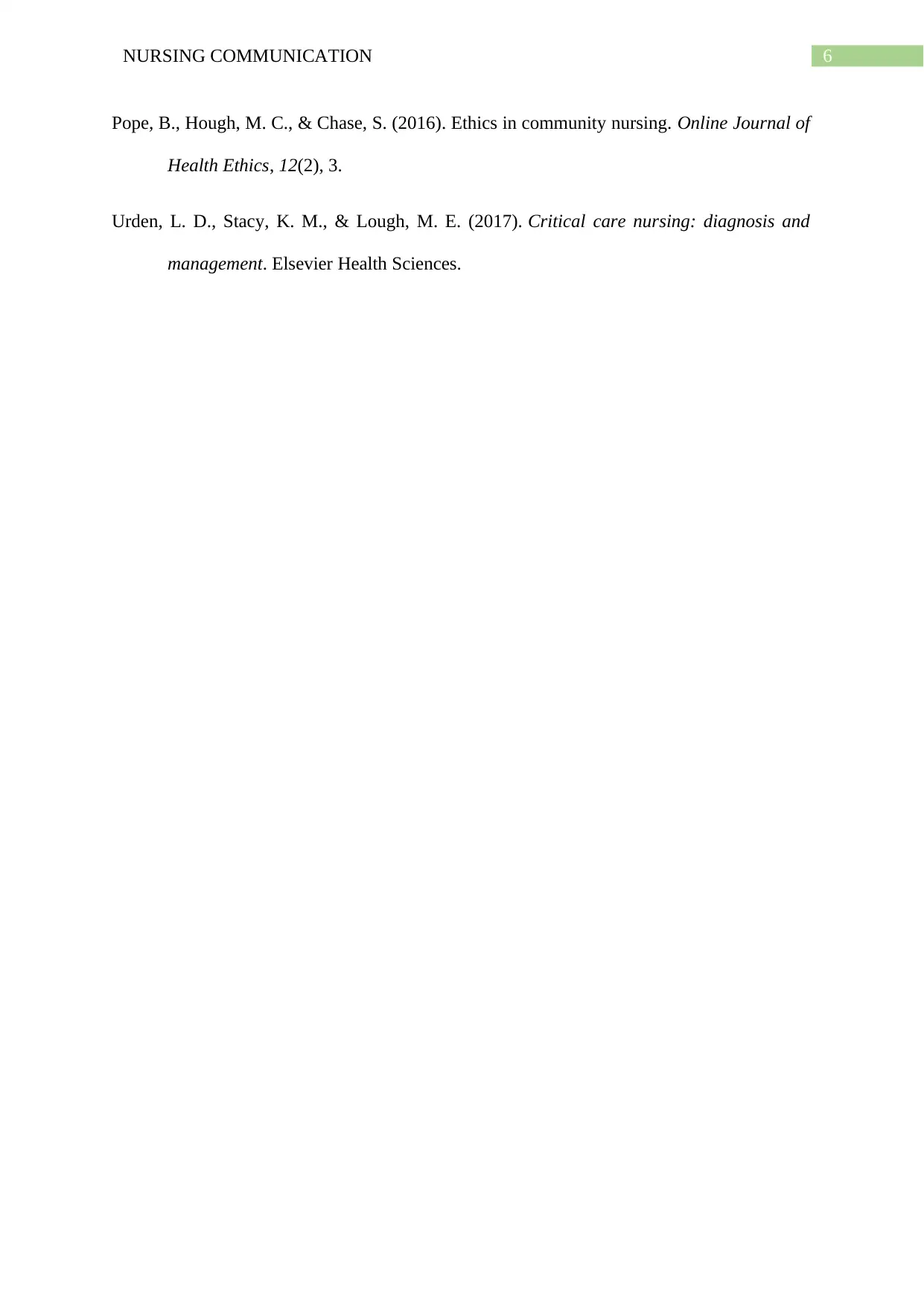
6NURSING COMMUNICATION
Pope, B., Hough, M. C., & Chase, S. (2016). Ethics in community nursing. Online Journal of
Health Ethics, 12(2), 3.
Urden, L. D., Stacy, K. M., & Lough, M. E. (2017). Critical care nursing: diagnosis and
management. Elsevier Health Sciences.
Pope, B., Hough, M. C., & Chase, S. (2016). Ethics in community nursing. Online Journal of
Health Ethics, 12(2), 3.
Urden, L. D., Stacy, K. M., & Lough, M. E. (2017). Critical care nursing: diagnosis and
management. Elsevier Health Sciences.
1 out of 7
Related Documents
Your All-in-One AI-Powered Toolkit for Academic Success.
+13062052269
info@desklib.com
Available 24*7 on WhatsApp / Email
![[object Object]](/_next/static/media/star-bottom.7253800d.svg)
Unlock your academic potential
Copyright © 2020–2025 A2Z Services. All Rights Reserved. Developed and managed by ZUCOL.





